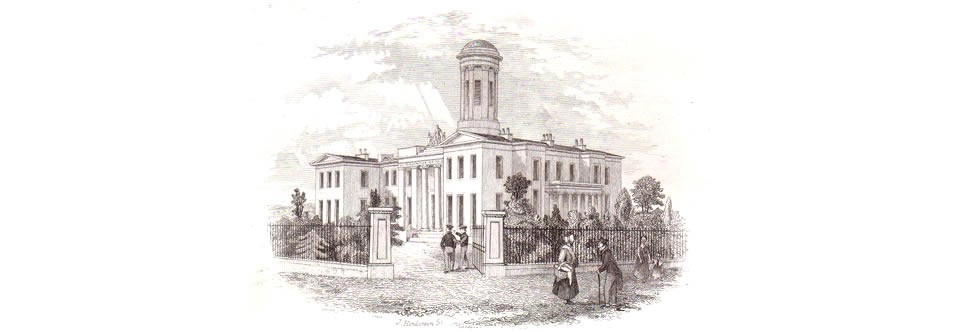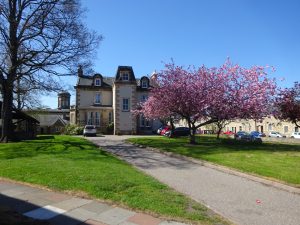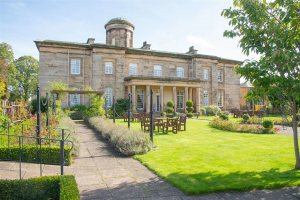Our story starts back in 1746 with the marriage of Marjorie Gilzean and a young man called Andrew Anderson. Andrew had joined a Hanovarian Regiment in Elgin. She and Andrew left Elgin when the Regiment moved South. Their travels are something of a mystery but it is likely they may have travelled as far as Spain or Gibraltar with the Regiment.
The next we hear of Marjorie was in 1748 when she arrived back in Elgin without her husband, whom we believe had been killed in action. She had travelled hundreds of miles on foot to get back to her native Elgin where she eventually arrived penniless and with a child in her arms. Her parents were both dead and she and her son, also named Andrew after his father, began to live a very harsh existence sleeping in the ruins of the Cathedral and relying on the generosity of local people.
As he grew up Andrew showed signs of being a bright lad and he was given a place at the Grammar School as ‘the pauper loon’. He progressed well at school and upon leaving became apprenticed to an uncle in Lhanbryde. This did not work out and he ran away to Leith and latterly to London where he found work in a tailor’s shop.
In 1760 Andrew was asked to deliver a suit of clothing to a Scottish soldier who was about to leave for India to join the Honourable East India Company. This gentleman offered to take Andrew to India with him. This was to prove a turning point in young Andrew’s life.
He never made any further contact with his mother and she eventually died in 1790. She lies buried in Kineddar Churchyard in Lossiemouth.
Andrew was commissioned as an Ensign in 1766 in the army of the Honourable East India Company. He proved himself to be a fine officer progressing steadily through the ranks and by 1811 had reached the rank of Major General – not bad for a ‘pauper loon’ from Elgin. It was possible to become very wealthy in the service as there were great prizes to be won and shared.
Perhaps influenced by his own upbringing Andrew Anderson executed a Deed of Trust in 1815 by which he left £70,000 to the Sheriff and Magistrates and Clergy of the established church in Elgin to build and endow an Institution in Elgin to provide a home for 50 children where they would be educated sufficiently to enable them to earn a living. The Institution was also to give a home to 10 aged persons.

General Anderson died in 1824 in London aged 77 and in 1830 Elgin Town Council commenced building on the lands of Maisondieu. The fine building of the Elgin Institute for the support of Old Age and the education of Youth was opened in 1832.
Though Andrew Anderson’s name is not inscribed anywhere on the building the home will forever be affectionately known in Elgin as Anderson’s, a proud memorial to one of the town’s illustrious sons.
Purpose
To provide excellent care services to older people, ensuring that they have a good quality of life and that their safety and wellbeing are always a priority.
Guiding Principles
At Anderson’s we believe that older people in residential care should be able to enjoy a quality of life at least equal to, if not exceeding, what was possible for them in their own homes.
We strive to maintain a culture that is positive, healthy and supportive where all staff feel valued and can contribute to the development of Anderson’s ensuring excellent care for residents.
We believe that older people who live at Anderson’s must receive the best quality care and attention according to their individual needs and circumstances. In order to meet these needs, we:
Provide comprehensive and ongoing training programmes so that staff are equipped with the necessary skills and knowledge to adequately care for our residents.
Maintain, improve and develop facilities, resources and technology for the benefit of residents and staff.
Promote and encourage choice for residents in their daily living.
Provide a programme of regular engaging and interesting activities.
Listen to our residents and their families and encourage participation and open communication by way of ‘house’ meetings as well as one to one conversations with staff through the key worker system.
Our Core Values
Our core values are reflected in our attitudes and behaviour towards all those who are part of the Anderson’s family and all who support the organisation:
Dignity – We believe people should be valued and respected.
Care – We show concern and consideration for others needs and feelings.
Trust – We rely on others’ honesty, commitment and strengths.
Competency – We appreciate people’s abilities, skills, knowledge and experience.
Working together – We realise that to succeed, co-operation and good communication are essential.
Creativity – We support an environment where people share the load, solve problems and develop new ideas and ways of working.
Our Culture – ‘The way we are’
Our culture is underpinned by our shared values, attitudes and beliefs and is influenced by our history, expectations, experiences, principles and philosophy. As a caring organisation, ‘how we are perceived’, ‘what we do’ and ‘how we do it’ are all very important to us. At Anderson’s we are:
- Welcoming and engaging
- Supportive and caring
- Passionate and enthusiastic
- Open and transparent
- Interested and progressive
- Focused and creative
Leadership is shared
At Anderson’s, we believe that leadership should be shared. At different times, members of our teams take responsibility for leading based on their role, experience and knowledge. Team members are encouraged to use their initiative helping to deliver our purpose and vision. We encourage everyone to have a voice in decision making and there is a strong focus on open communication.
The Anderson’s Institution was designed in 1830 by Archibald Simpson who was probably the north of Scotland’s most important classical architect of the 19th century.
The building attached to Anderson’s Care home on the south side was originally part of the whole complex but is now leased by Moray Council for use by East End Primary School. This building was also designed by Simpson and extended by John Wittet in 1903. Both the main building and the school are built in a matching style from finely-cut sandstone and they appear to survive largely as seen in 1903.

Easton House, a large detached period residence adjacent to the main building was constructed around 1850. It was purchased by Mr Edward Stroud Harrison on behalf of James Johnston and Co and donated to the General Anderson’s Trust in October 1960.
Anderson’s main building comprises 4 separate houses. Together with Easton House, they make up five small individual communities who all have their own dedicated teams of care staff.
We are extremely fortunate to have a variety of extensive gardens within our grounds. For those who wish to relax in tranquil surroundings, the south facing sensory garden enjoys the sunshine for most of the day. We also have the more formal setting of our Heritage Garden, where we host our annual Garden Party in summer-time.
Facing eastwards to catch the morning sun, sits our summerhouse where our residents can enjoy a morning coffee and a catch-up with friends and family.
Towards the rear of the Heritage Garden we have our productive vegetable and fruit garden with raised beds providing efficient use of space and easy access for planting.
Structure
Anderson’s Care Home is a Scottish Community Interest Organisation (SCIO) operating as ‘The General Anderson Trust’. It is a registered Charity (No. SCO 11277).
The organisation is non-profit making with all funds committed to the operation of the home and welfare of the residents of the Home.
Governance
The Trust is managed by a Board of 13 volunteer Trustees (Governors) whose role is to ensure compliance with legal, financial, health and other regulations and to assume oversight of all aspects of the operation. The Care Home Manager, supported by a small senior management team, is responsible to the board for day to day operations. Trustee’s are drawn from the local community and have a wide range of skills and expertise in the following areas:
- Legal
- Medical
- National Health Service management
- Accountancy, Banking and Finance
- Voluntary sector including social enterprise
- Ministry
- Local government
- Property management
- Strategic management and planning
- Business administration
The Board meets bi-monthly and is accountable to the Scottish Charities Commission for its stewardship of the sizeable budget required to conduct the business of maintaining and running a modern residential care home for the elderly.
There are two sub Committees: Finance and House and Refurbishment (H&R). Each has an experienced Chairperson who reports to the Board. Trustee’s are allocated to each committee based on their experience and knowledge. These committees meet monthly and the Chair of the board will also attend.
Aspirations
Trustee’s work hard to support the Care Home Manager and staff to maintain and improve the quality of care for residents. They strive to ensure that Anderson’s:
Is a place where residents feel at home and their care and support always takes priority.
Staff are well trained and able to meet the increasingly complex needs of residents.
Meets the Care Inspectorate standards to as high a level as possible.
Maintains its reputation being considered to be the best care home for older people in Elgin and surrounding area.
Is well led and managed.
Has effective and robust processes in place that support the needs of residents as well as ensuring efficient day to day operations.
Is a good place to work with a positive and caring culture and environment.
Is open and outgoing engaging with the wider community.

